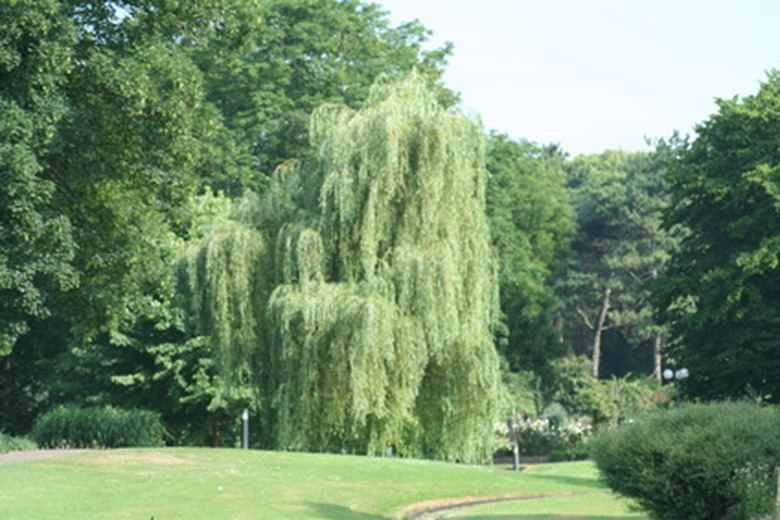How To Stake A Weeping Willow
Though, as the name implies, it is the Weeping Willow's nature to bend with its branches touching the ground instead of reaching for the sky, you can help your Weeping Willow add some height by staking the tree at the base while it is still forming. Once staked, the Weeping Willow has a stronger central trunk that can stand upright, but the top of the tree above the stake and the branches still bend naturally.
Step 1
Hang a windsock in the area of your yard where the Weeping Willow is planted. Watch the windsock for a few days. You should see a trend as to which direction the wind blows. This is the prevailing wind in your area.
Step 2
Hammer a wooden stake into the ground directly beside a newly planted Weeping Willow using a rubber mallet. The stake should be just shorter than the tree itself and located on the side of the tree that faces the prevailing winds.
- Though, as the name implies, it is the Weeping Willow's nature to bend with its branches touching the ground instead of reaching for the sky, you can help your Weeping Willow add some height by staking the tree at the base while it is still forming.
- You should see a trend as to which direction the wind blows.
Step 3
Select a thick central branch of the Weeping Willow to serve as the main trunk of the tree. Gently hold it up to its full height against the stake.
Step 4
Tie the central branch to the wood stake with tree ties. Use enough of the ties to make sure that the branch stays flush against the stake from top to bottom.
Step 5
Leave the stake in place on the tree until the Weeping Willow has grown to the height that you want. When the tree grows taller and a trunk forms, you can wrap a tree guard around the base of the tree to protect it from damage.
Step 6
Remove the tree guard, ties and stake when the tree has reached an acceptable height. The tree should continue to develop naturally.
- Select a thick central branch of the Weeping Willow to serve as the main trunk of the tree.
- Leave the stake in place on the tree until the Weeping Willow has grown to the height that you want.
Weeping Willow Seeds
Weeping willow seeds are borne in capsules that measure 1-inch in length. For this reason, it is best to collect the seed capsule before it pops open in spring. The ideal time is when it turns from green to yellow. Seeds may remain viable for one month if they are kept moist and refrigerated in a sealed container. Weeping willow tree seeds have no dormancy period and do not require any special pregermination treatment. Keep the medium slightly moist during germination. When the seedling reaches 6 inches in height, transplant it into a 1-gallon container filled with commercial potting soil and increase the amount of sunlight it receives, gradually, until it is in full sun. The ideal time to plant it outside is in early spring, after the danger of frost has passed. Weeping willow trees grow quickly – 8 to 10 feet per year – once they are planted in the landscape.
- Weeping willow seeds are borne in capsules that measure 1-inch in length.
- When the seedling reaches 6 inches in height, transplant it into a 1-gallon container filled with commercial potting soil and increase the amount of sunlight it receives, gradually, until it is in full sun.
Things Needed
- Windsock
- Stake
- Rubber mallet
- Tree ties
- Tree guard
References
- KSU: Master Gardener–Pruning Weeping Trees and Shrubs
- North Carolina State University: Salix Babylonica
- Nature Hills Nursery: Weeping Willow
- The Reference Manual of Woody Plant Propagation; Michael A. Dirr
